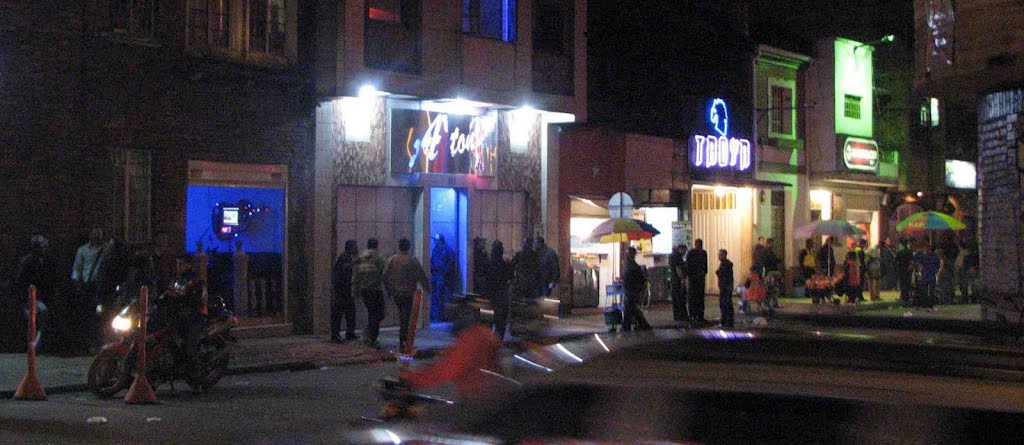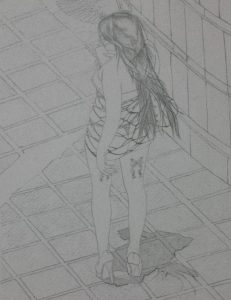
The Santa Fe district in Bogotá.
Fayida Jailler speaks to two artists who are working to capture the realities of Santa Fe, an area that has become synonymous with sex
Once a prestigious district, home to poets, intellectuals, traders and merchants, Santa Fe is now a red light zone, home instead to strip clubs, sex workers and brothels.
Austrian architect, Karl Brunner, laid the framework for the area’s urbanisation in the 1930s as part of a citywide development plan. The majority of the original inhabitants were Europeans, many of them Jews, fleeing the horrors of World War II.
Now only a few traces of faded grandeur and elegant houses remain amidst the neon signs. The neighbourhood’s decline began about 70 years ago due to the heavy influx of migrants arriving in Bogotá, impacting the Santa Fe barrio. Landlords began dividing and subdividing the large colonial buildings, providing accommodation for a never ending stream of people. As the city was rocked by the violent tensions that followed Gaitan’s death in 1948, people abandoned the once-affluent area.
Art of observation
One of the district’s more famous residents, poet León de Greiff, passed away many years ago, but local artists William I. Martinez and Sergio Enciso believe that there is still a place for art in the neighbourhood.
The pair have been working together for the past five years to capture daily life there. William is an artist who has been living in Santa Fe since 2010, and Sergio has been collaborating with him since 2011.
The two artists go back a long way, having met in 2000 while studying art at the Universidad Nacional. They have spent a lot of time talking to people, walking the streets and absorbing the atmosphere.
Their most recent project was an exhibition last year, entitled ‘Hija de Pu’. William’s contribution consisted of a series of drawings, photographs and videos. In conjunction, Sergio hand wrote extracts of his book of cronicas entitled Mariposas de Burdel (Brothel Butterflies) on the walls, a collection of brief but poignant observations from his time spent exploring the neighbourhood.
The front cover of the book is a prostitute that the two artists fondly refer to as ‘Blankis’, with two bows tattooed on the back of her legs, a persona who also features in one of Sergio’s cronicas.
Zona de Alto Impacto
Many bogotanos mistakenly refer to Santa Fe as a Zona de Tolerancia, one of several sites where prostitution, although illegal, is tolerated by the authorities. However, the district is actually a Zona de Alto Impacto (ZAI), making it the only area in the country where prostitution is completely legal.
The ZAI was introduced 2002, when the then mayor, Antanas Mockus – who surprisingly was born in Santa Fe – decided to regulate prostitution in Bogotá by dedicating a specific area where the sex trade, and all its offshoots, would be concentrated and could operate legally. The ZAI is located between Avenida Caracas and Carrera 17, and Calle 19 and Calle 24.

The front cover of Sergio’s book is a prostitute that the two artists fondly refer to as ‘Blankis’, drawn by Willian, with two bows tattooed on the back of her legs. Photo: William I Martinez
“You never get used to it,” Sergio tells me as we stroll around the neighbourhood, “seeing half naked women walking openly in the streets. It never becomes normal.” And certainly, apart from the red light district in Amsterdam, it is the only place I have been where prostitutes solicit so openly. Unlike in Amsterdam where the sex workers pose behind glass windows, here the women walk freely in the streets, wearing thongs, fishnet tights, miniskirts and dresses, watching on as potential clients scout out which lady they find most appealing. We see other prostitutes eating in cafes on their lunch breaks. They work shifts, some taking the mornings and others preferring to work at night.
It is surreal – though unsurprising – to witness this open prostitution alongside everyday life. There are hairdressers, bakeries, laundrettes and churches. We make a stop at a stationery shop, and in the middle of the counter, amongst the pens and office materials, is a clear glass bowl of thongs, one of which William buys for a mere COP$3,000.
Sergio points out a pañalera (literally a shop that sells babies’ nappies) on the corner. It is a shop intended for the working mothers of Santa Fe, with a colourful array of lingerie, camisoles and other attire hanging across a wall on one side. In contrast, there are packets of nappies and other baby care items at the back.
While this is an active prostitution zone, it’s also a place where people live and raise their families, as shown by the large nursery that stands right in the midst of the motels, residencias and stripclubs.
It’s easy to be seduced by the almost carnival-like atmosphere, but one should not forget that this is an area plagued by huge social ills. NGOs report of overcrowding, poverty, drug addiction and crime – all problems that those who live here have to face every day. That’s precisely part of what William and Sergio’s art is about. William captures some of these aspects of life in his Instagram photos; pictures of sleeping homeless people, dilapidated buildings, scattered rubbish and human faeces.
He unashamedly describes some of his photos as ‘pornomiseria’ or ‘poverty porn’, elements of the deprivation in Santa Fe that are morbidly fascinating to outsiders.
Sergio explains that William is interested in viewing and showing the daily realities of prostitution. “In this regard, the intention is to show the problems that exist there and are part of everyday life. Substance abuse and exploitation are part of the practice of prostitution and of the ZAI, and are topics that deserve a lot more consideration and debate.”
Discretion
There is a noticeable segregation between the cisgender prostitutes and the transgender workers, who tend to occupy the streets from Calle 20 going south. The artists explain that this is because several owners of the clubs and motels were afraid that transgender workers would damage the reputation of their businesses, and so demanded that they occupy their own, separate area. The cisgender prostitutes are fiercely protective of their identities, with Sergio adding he has seen them become physically aggressive with clients attempting to take photos in the street.
For that reason, William has to be fairly discreet about his work. Up in his flat he has constructed a special curtain that creates the same effect as a tinted window; he can see out, but passers-by below can’t see in. Within the curtain, there are small holes just large enough to accommodate the aperture of his camera. He’s also built a small chaza (cart traditionally used by street vendors) that he can hide inside and take photos from street level without being seen.
While working in secret may seem unfair, Sergio explains “When I am writing about someone, whether in the ZAI or in another part of Bogotá, about artists or personalities, what I am doing is trying to get to know them so that I can represent or show them.”
“In the case of the ZAI, I write to show the dynamics and the practicalities that exist inside this territory, which emerge when a traditional barrio meets the business of prostitution.”
William speaks more bluntly about the dynamics of selling sex, saying he is interested in “the transaction, the negotiating…how do you say in English? The business of the fuck.”
He says there is a type of freedom amongst those who live on the margins of society. For example, he explains that people who live in the street don’t have to follow the same rules and social norms; they sleep at random on the pavement, wherever they can find a place to put their head. For him, the prostitutes are also liberated, free with their bodies and with their sexuality.
Sergio and William intend to publish a book that combines all their research and work – photographs, drawings, texts, interviews and historical background – to show “the reality of migration and prostitution in Bogotá”.
“We still have a lot of stories to tell,” Sergio says, “places to see, people to talk to and questions to answer about the ZAI and Santa Fe. This is just the beginning.”
For more on Sergio and William and their work, go to: www.hijadepuarte.wordpress.com
By Fayida Jailler





